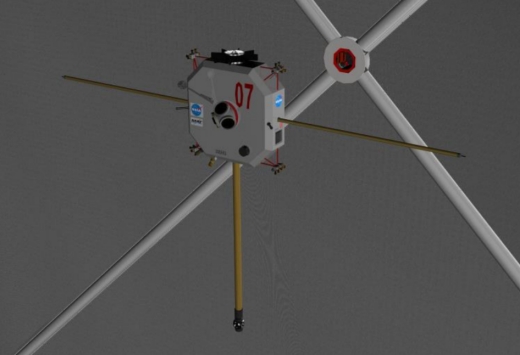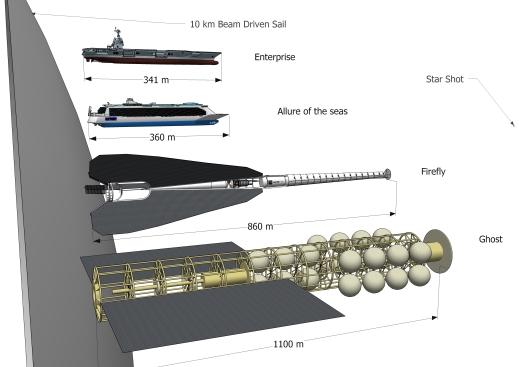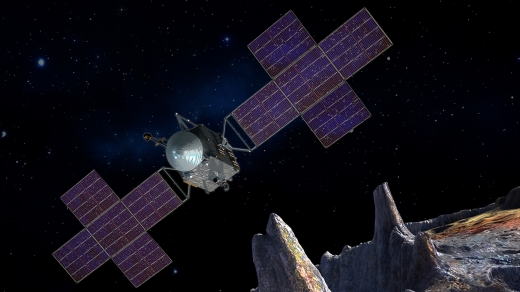Centauri Dreams
Imagining and Planning Interstellar Exploration
SSEARS: Background of a NIAC Study
I always keep an eye on what’s going on at the NASA Innovative Advanced Concepts office, which is where I ran into Jeff Nosanov’s Phase I study for a solar sail called Solar System Escape Architecture for Revolutionary Science. At the Jet Propulsion Laboratory, Jeff managed flight mission proposals and supported the radio isotope power program. He now lives in Washington DC, a technology entrepreneur whose fascination with spacecraft design has never diminished. In the essay below, Jeff explains the background of his first NIAC award (a second, PERIapsis Subsurface Cave Optical Explorer, would lead to Phase I and Phase II grants), and gives us an idea of the ins and outs of making ideas into reality at NIAC and JPL. For more, the website nosanov.com is about to go online, and Jeff’s new podcast debuts today.
By Jeff Nosanov

It’s an honor and a privilege to be asked to write about my near-interstellar mission work for the Tau Zero Foundation. Marc’s book and Paul’s writing were very inspiring to me as I began working at JPL and dove into the interstellar mission community. This article will describe my journey to JPL, the process of proposing the mission concept, and the experience of managing the project. The mission concept itself can be read about here.
In summary, SSEARS (Solar System Escape Architecture for Revolutionary Science) is a solar sail-based mission to return to the heliopause (the edge of the solar system) to continue the Voyager science. The driving goal was to determine the fastest possible propulsion method to return to the outer solar system. We concluded that it was possible to get there in about 18 years (half the time it took Voyager) using a very large solar sail system. How did we get to this point? I’ll start at the beginning.
A Child’s View
One of my favorite childhood photos was taken at the Griffith Observatory in Los Angeles. I don’t quite remember this event, but I do strongly remember a later one, my visit at age 5 in 1987 around the time of the Voyager 2 Neptune encounter. My dad took me there to look through the big telescope at Neptune, and told me of the spacecraft that was nearing the ice giant planet.

I distinctly remember the “mind blown” moment of realization that such things were possible. I also learned that day about JPL, the NASA lab just a few dozen miles from the Griffith Observatory where the Voyagers, and so many other spacecraft, were built. I didn’t know it until much later but that event turned me into a space guy. I also recall a conversation with my dad from around that time in which he told me that we can visit other planets, but not other stars. That stuck with me.
Image: Photo of Jeff as a baby being held by his mother at Griffith Observatory.
As a child it is easy to have a fairly distorted view of what NASA actually is, and what it does. It’s tempting to imagine something out of Star Trek, with wild and amazing technologies in development all around. In reality, only a small part of NASA, the NASA Innovative Advanced Concepts Program (NIAC), embodies that exciting vision, as I discovered as an adult.
Working at JPL
About 22 years later I started working at JPL on January 4th, 2010. Suddenly the greatest deep space exploration playground was opened to me. I was extremely eager, giddy even, to learn about this work and discover how I could contribute. I began to learn everything I could about everything I could access. I spent many hours reading books in the library (especially Frontiers of Propulsion Science) and talking to as many people, especially senior people, as possible. I especially stalked the Voyager program people.
My general knowledge about how NASA missions are developed, selected, funded, built, and operated grew. I began to pay attention to RFPs (Requests for Proposals) and BAAs (Broad Agency Announcements) that came through the daily emails. I eventually pieced together the realization that anyone could propose concepts (at nearly any stage of development) to various programs within NASA. But how to possibly find the right combination of ambition, team, capability, vision, most importantly a receptive NASA program?
I spent many hours with program managers, scientists and engineers learning about the current challenges and capabilities in deep space exploration. I was extremely grateful at the time, but in retrospect I have even greater appreciation for the time spent with me. It was only through the kind support of managers, engineers, scientists and many others that I developed the general background knowledge to attempt the work that became my project.
Eventually I came to learn about the NIAC program. That program exists to fund revolutionary concepts that significantly increase exploration capability. This is distinct from the majority of NASA projects, which largely seek to minimize technological risk. The NIAC program exists as a way to ensure that investments in promising, ambitious technology get made, and to reduce technological stagnation as the risk-minimizing forcing functions of most other NASA programs run their course.
Stalking Voyager
I knew I wanted to make a dent in interstellar flight, so I spent a lot of time with people from the Voyager program. I tried to learn everything I could about the mission to develop a mission concept that would be worth doing scientifically. Around this time NASA had been planning to fund a technology demonstration mission for a concept called SunJammer. This was to be a solar sail mission to a Lagrange point, using the sail for propulsion and station-keeping. I decided that a NIAC-worthy proposal would be to start with just how large we could reasonably build a solar sail, and then see how fast such a system could reach the heliopause with a scientifically valuable payload.
I approached Ed Stone at Caltech with child-like reverence. Stone was project scientist for Voyager and a former director of JPL itself. I wanted to ask him what he would do to follow Voyager if he had a limitless budget. To my surprise he accepted my meeting request, and we had several meetings in which he outlined a scientific payload designed entirely for the heliopause region. This became the “mission” that the hypothetical giant solar sail propulsion system would uniquely enable.
Writing the Proposal
JPL has several systems in place to help people write successful proposals. Each proposal opportunity announcement from NASA results in a mentoring and guidance resource from the responsible JPL program office. I took great advantage of this resource for the first few proposals of my career and it has made a world of difference.
The theme across many proposals for many agencies in my experience is the importance of genuine, exciting storytelling. Thinking back, that was all I had for my first effort! The process of writing the proposal exposed me to a great many inner workings of JPL including program management, costing, and even obtaining submission authority. I doggedly, perhaps obsessively, followed the process to ensure that all the rules were followed and I felt a deep sense of relief and excitement once the proposal was fully submitted. However, I did not have any way of estimating my chances for success due to my lack of experience. I moved on with my regular work and hoped.
Months later I got a most unexpected phone call telling me that my proposal had been selected! I was over the moon, and I felt something very powerful for the first time: My ideas are good and are worth pursuing. I felt a change in responsibility. The proposal development process was partly for my own personal satisfaction and growth. It was a wonderful experience. Now, having been selected, I had the privilege of having the responsibility of discovering something new about the universe and our place in it.
Outcome
One of the important lessons I learned is to keep the long term goal in mind. In our case, this specifically meant figuring out the fastest possible way back to the heliopause with a science payload worth taking there. It turned out that we could get there in 18 years with a 250m x 250m solar sail and a “Voyager on steroids” payload.
This rendering shows our vision for the spacecraft, and a small part of the solar sail behind it.

Towards the end of the study I made another appointment with Ed Stone. I told him what we had learned. He looked me in the eye and said “Wow.” I’d like to imagine that in that one moment he was the 5 year old looking at the sky, his mind bursting with possibilities, instead of me.
Impact
We ultimately submitted a proposal for Phase 2. Unfortunately intervening events ended the possibility in the foreseeable future for significant progress on our work. We had relied upon the NASA excitement in the SunJammer program to chart the course for solar sail work. That program was cancelled and so we did not have a path forward to advance the technology, and without that potential synergy it seemed that a NIAC phase 2 award was unlikely.
Still, I was satisfied and inspired by our results. I must conclude that the relative impact, in the grand scheme of things, of our study was small, perhaps incremental. However the experience drastically changed my goals and ambition. Ultimately my study is one of many that attempted to explore the limits of what human ingenuity and curiosity can achieve.
Conclusion
I became a father on May 4, 2012 in the middle of the study period. This event fundamentally changed the way I think about space exploration and my own role in it. I enjoyed bringing my son to the Griffith Observatory for many reasons. During the Griffith Observatory visit in which this photo of my son was taken I recalled my dad’s statement that we can travel to other planets but not other stars. As of June 2nd, 2017 now that is still true…

… but we’re working on it.

Enceladus: Evidence for Asteroid Impact?
How to make sense of Enceladus? The moon’s famous jets of water vapor, mixing with organic compounds, salts and silica, first revealed the possibility of an ocean beneath the icy surface, and the Cassini orbiter has treated Enceladus as a high priority target ever since. But why the asymmetry here? After all, while the south polar region includes the active ‘tiger stripe’ fractures associated with the plumes in a geologically young area, the northern pole shows much more cratering, evidence for a considerably older surface and, obviously, no plumes at all.
Perhaps, say astronomers from NASA, the University of Texas and Cornell, we’re dealing with an ancient impact, one that completely re-oriented Enceladus by tipping it about 55 degrees away from its original axis. Thus we get fractures well over 100 kilometers long in the south, evidence for an asteroid strike in what would have once been an area close to the moon’s equator. Radwan Tajeddine (Cornell University) is a Cassini imaging team associate and lead author of the paper on this work, which recently appeared online in Icarus:
“The geological activity in this terrain is unlikely to have been initiated by internal processes,” says Tajeddine. “We think that, in order to drive such a large reorientation of the moon, it’s possible that an impact was behind the formation of this anomalous terrain.”
Giving weight to the hypothesis is the presence of a series of basins that can be detected across Enceladus’ surface. The researchers believe these are traces of a previous equator and poles. The features visible to Cassini would also reflect underlying variations in the ice shell. Such an impact would have caused Enceladus to wobble, finally re-establishing stability over the course of at least a million years. The alteration to the north-south axis resulting from this is known as ‘true polar wander,’ changing the locations of north and south poles.

Image: These maps look toward the icy moon’s southern hemisphere, with colors representing highs and lows. Purple represents the lowest elevations, while red represents the highest. The map at left shows the surface of Enceladus in its possible ancient orientation, millions of years ago. The chain of basins representing topographic lows can be seen in blue and purple, running along the equator, with an additional low region around the original south pole. The region that encloses the moon’s currently active south polar terrain, with its long, linear “tiger stripe” fractures, would have been at middle latitudes just south of the equator. The map at right shows the current orientation of Enceladus. Credit: NASA/JPL-Caltech/Space Science Institute/Cornell University.
Thus if we simply re-orient Enceladus by about 55 degrees of latitude, the pair of depressions found by the researchers lines up with a much older equator and poles. And we have an explanation for the existence of the ‘tiger stripe’ fractures and their jets. An Enceladus without jets would have been visually less dramatic, but the impact theory also reminds us that other moons without telltale geysering activity may conceal internal oceans of their own.
The paper is Tajeddine et al., “True polar wander of Enceladus from topographic data,” published online by Icarus 30 April 2017 (abstract).

Remembering Ben Finney (1933-2017)
Ben Finney, the editor (along with Eric Jones) of Interstellar Migration and the Human Experience, has died at age 83. A professor emeritus at the University of Hawaii, Finney died quietly at a nursing home in Kaimuki, according to this obituary in the Honolulu Star-Advertiser. There is much to be said about this visionary man, but I begin for our purposes with his contribution to deep space studies and interstellar thinking.

For Interstellar Migration and the Human Experience, which I bought not long after it came out in 1986, turned out to be one of those key texts, and I am hardly the only person who was transformed by the ideas in its pages. I bought it purely on the basis of its title. Not yet aware of the serious studies into interstellar flight that were then being published in the journals, I marveled that here was a text that put human movement to the stars into a serious scientific and historical context and saw it as an apotheosis of the species.
Image: Anthropologist and author Ben Finney. Credit: Polynesian Voyaging Society.
Paging through the book, I quickly realized that it was a series of papers from a conference of the same name that had taken place at Los Alamos in May of 1983. The conference was a multidisciplinary event ranging from astrophysics to anthropology, looking into societal migration, emerging technologies, resource acquisition and the critical human factors underlying all exploration. Finney’s own contributions emphasized not just the technically possible but the emotionally resonant, stressing exploration as an imperative of the species.
Thus we come to the peopling of the Pacific islands. Finney had an ear for language and a sense of deep time. Here he’s talking about exploration over long time-frames:
The whole history of Hominidae has been one of expansion from an East African homeland over the globe and of developing technological means to spread into habitats for which we are not biologically adapted. Various peoples in successive epochs have taken the lead in this expansion, among them the Polynesians and their ancestors. During successive bursts lasting a few hundred years, punctuated by long pauses of a thousand or more years, these seafarers seem to have become intoxicated with the discovery of new lands, with using a voyaging technology they alone possessed to sail where no one had ever been before.
Before reading Interstellar Migration, I had given little thought to historical corollaries that could prepare us for a possible future among the stars. These days, thanks to Finney’s work, we’re used to seeing the analogy with the Pacific islands made, to the point that its strengths and weaknesses have been debated frequently in the literature (and certainly in the comments sections on this site over the years). But it was Finney’s unique background that made it possible for him to develop the Polynesian experience in deep space terms:
Once their attempts to cope with the rising sea levels of the Holocene committed them to sea, the first pioneers of this lineage of seafarers had good reasons to keep going. The continental mindset of their distant ancestors would have faded as successive generations pushed farther and farther east, to be eventually replaced by the more accurate view that the world was covered with water through which bits of land were scattered. They therefore knew that in pushing into the open ocean they were entering not a vast empty region but one teeming with islands. What is more, after leaving the Bismarck Archipelago and outdistancing their less sea-adapted rivals, they would have realized that before them lay an ocean of islands accessible to themselves alone. What more invitation did they need?
An invitation indeed. Now, as to Finney’s background: He was an anthropologist, a Harvard Ph.D who taught for thirty years at the University of Hawaii at Manoa, where his courses included Human Adaptation to the Sea and Human Adaptation to Living in Space. It was back in the 1950s that his exposure to a book by Andrew Sharp raised his hackles, arguing as it did that Polynesians had populated the Pacific islands more or less by chance, driven by the vagaries of wind and tide. Finney decided it was a theory that could be contested.
To do so, he built a Polynesian sailing canoe christened Nalehia, followed by a larger craft, the H?k?le?a, which Finney sailed with a small crew from Hawaii to Tahiti. A founder and first president of the Polynesian Voyaging Society, Finney was convinced that the Polynesians had been capable of extraordinary feats of navigation and deep ocean voyages in open craft. That he proved such voyages were possible is attested to by the fact that some 25 similar canoes are now making voyages in the Pacific islands. Hokule’a itself is finishing up a three-year circumnavigation of the Earth, with return to Hawaii slated for some time in June.

Image: Hokule’a arrival in Honolulu from Tahiti in 1976. Credit: Phil Uhl/Wikimedia Commons.
Space was never far from Ben Finney’s thinking. He was a research associate at NASA Ames on SETI issues in the 1990s and held a faculty appointment at the International Space University, in addition to his other appointments at UC-Santa Barbara and the University of French Polynesia. His career was wide-ranging enough to take in nuclear waste disposal (working with Sandia National Laboratories) and robotics. But for most people, it will be the Polynesian experience in one way or another that will always define Ben Finney.
Moreover, the future he envisioned was one of endless speciation, given the distances to the stars. Let me wrap up with the conclusion to his “The Exploring Animal,” written with Eric Jones and the lead-off paper in Interstellar Migration and the Human Experience:
Human evolution in space will hardly be limited to the birth of a new species. Space is not a single environment but an Earthcentric residual category for everything outside our atmosphere. There are innumerable environments out there providing countless niches to exploit, first by humans and then by the multitudinous descendant species. By expanding through space we will be embarking on an adventure that will spread an explosive speciation of intelligent life as far as technology or limits placed by any competing life forms originating elsewhere will allow. Could the radiation of evolving intelligent life through space be the galactic destiny of this Earth creature we have called the exploring animal?
Addendum: Savage Minds, an excellent venue for discussion of anthropology, has a detailed article on Ben Finney that I highly recommend. Thanks to Randy McDonald for the tip.

Comments on Near-Term Interstellar Probes
If you have questions about beamed energy concepts, James Benford is your man. A plasma physicist who is CEO of Microwave Sciences, Benford has designed high-power microwave systems for the likes of NASA, JPL and Lockheed. Now Chairman of the Sail Subcommittee for Breakthrough Starshot, he is deep into the investigation of sail materials and design, as he explains below. After reading Greg Matloff’s Near-Term Interstellar Probes: Some Gentle Suggestions, Jim passed along his comments, which highlight the need for a dedicated laboratory facility to explore the Starshot possibilities. He offers as well his thoughts on where sails stand in the overall propulsion landscape, a position of growing significance.
By James Benford

My colleague and old friend Greg Matloff has given us a well-informed broad survey of propulsion options for interstellar flight. I’m going to contribute a few comments.
Even a century-long flight to Alpha Centauri requires a velocity of ~10,000 km/sec, which is about 500 times the fastest velocity that any human object has reached by rocket propulsion — Voyager 1 is at about 17 km/sec. On the way to getting to a velocity like 10,000 km/sec, we’re going to enable fast missions for exploration and development of the solar system and the near-interstellar region around us.
Beamed Energy Propulsion
The cubesat experiments described by Greg would probably have to be fairly massive in order to produce any substantial velocity. It’s far more expeditious and far less expensive to do such experiments in evacuated chambers in the laboratory. After all, the only flight experiments that been conducted to date, which I participated in 16 years ago, were conducted in just such apparatus. That’s the most straightforward way to demonstrate stability and high acceleration. No such laboratory exists at present.
I’m hoping that Breakthrough StarShot will soon develop such a Beam-Driven Sail Test Facility, because the pressing matter of stability and high acceleration will take some time to be researched. Of course such a laboratory has to be designed and built and that would take a year at least. The most suitable beam source will be either microwave or millimeter-wave, because they can be obtained off-the-shelf at high power and have quite reasonable costs of a few dollars per watt. (Lasers are now in the hundreds of dollars per watt range.)
Such a Beam-Driven Sail Test Facility would conduct experiments on the key Starshot issues, in order of priority:
1) Beam-riding stability of various sail shapes.
2) Sail material and its properties: to maintain a high reflectance with very little beam absorption or transmission.
3) Ability to sustain high acceleration, which is necessary in order to achieve high velocities.
The Cosmos-1 experiments we (the Planetary Society, Microwave Sciences and JPL) had planned to do, and which unfortunately didn’t happen because of the launcher failure, should certainly be looked at again. We were ready to carry out an experiment to irradiate the sail with the Deep Space Network beam from Goldstone. This could have demonstrated beamed propulsion of a sail in space. The 450 kW microwave beam from the large 70-m dish can show direct microwave beam acceleration of the 30-m sail by photon pressure, and we can measure that acceleration by on-board accelerometer telemetry.
The key thing to do is to measure the acceleration on the spacecraft with an on-board accelerometer. The alternative, deducing acceleration from orbit changes, would depend upon multiple transits of the sail through the beam. It would be hard to winkle out of orbital data, especially if the acceleration is small. [see “MAX-Microwave Acceleration eXperiment with Cosmos-1,” James Benford, Gregory Benford and Tom Kuiper, Proc. Fourth IAA Symposium on Realistic Near-Term Advanced Scientific Space Missions, also JBIS 59, pg. 68 (2006).]
Greg Matloff is certainly correct to point out that the sail material for Starshot must be able to reconfigure its shape. It must have very precise and accurate pointing and tracking, at both Earth and the star that it is approaching. The sail must be a very smart material with embedded and distributed artificial intelligence. How to provide the energy for reconfiguring the shape of the sail is one of the many challenges of Starshot.
Thermonuclear Fusion Rockets
Greg gives a good list of the many technical problems that face fusion rockets. Of course the greatest problem is to produce a fusion reaction at all! For interstellar flight they will be very large, very inefficient and very costly.
For comparison, here are some key parameters of a US supercarrier, two Icarus design concepts and the Starshot sailship:
- Aircraft Carrier 0.3 km, 105,000 tons, 0.01 T$
- Firefly 0.75 km, 23,550 tons, mass fraction 0.0064, rocket cost 40 T$, 4.7% c
- Ghost 1.2 km, 154,800 tons, mass fraction 0.0008, cost 0.02-34 T$, 6% c
- Large Sailship 10 km, 10 tons, mass fraction ~0.1, Beamer cost 40 T$, sailship capital cost ~ 1B$, 10% c [operating cost, electricity to drive the Beamer at today’s rate (0.1 $/kW-hr) is 0.5 T$.]
- Starshot ~3 m, ~1 gram, capital cost ~10B$ [operating cost ~6 M$.]
And for a size comparison, see Figure 1. The ships that explored the oceans, such as the Santa Maria (19 m) and Kon-Tiki scale Polynesian rafts (45 m), as well as the Breakthrough Starshot sail (~3 m) could not be visible on this scale.
With the fusion rocket approach, the infrastructure necessary to build such huge vessels and supply nuclear fuel is a fixed cost. It is not easy to estimate, but will be quite huge.

Figure 1. Scales of Starships compared with largest Earth vessels. From top, largest Earth ocean ships, Firefly, Ghost, 10 km diameter Sailship, all to scale. The ~3m Breakthrough Starshot sail is actually not visible on this scale. (Figure from Michael Lamontagne).
The concept that Freeman Dyson originally proposed, using nuclear materials out of the nuclear arsenals to make explosives to drive starships, is a bit out of date now. As you can see in figure 2, the Cold War adversaries have been radically reducing the warheads they have, the rapid progress beginning during the Reagan-Gorbachev era. The Nunn-Lugar Cooperative Threat Reduction program deactivated more than 7,600 nuclear warheads. Highly enriched uranium contained in them was made into commercial reactor fuel which was purchased by the U.S. Few Americans realize that during the last several decades a fair amount of the electrical power the United States was generated by burning up Russian nuclear materials in fission power reactors!
There are now a few thousand nuclear explosives compared to the hundred thousand at the peak of the Cold War.

Figure 2: History of Nuclear Stockpiles.
Conclusion
Beam-driven propulsion is more firmly grounded and credible than nuclear fusion propulsion, as in Project Icarus. Fusion rockets remain far-term, distant on a timescale of decades, if not centuries. In today’s funding environment, that’s not likely to change: Due to Starshot, sails are becoming near-term.

Near-Term Interstellar Probes: Some Gentle Suggestions
When Greg Matloff’s “Solar Sail Starships: Clipper Ships of the Galaxy” appeared in JBIS in 1981, the science fictional treatments of interstellar sails I had been reading suddenly took on scientific plausibility. Later, I would read Robert Forward’s work, and realize that an interstellar community was growing in space agencies, universities and the pages of journals. Since those days, Matloff’s contributions to the field have kept coming at a prodigious rate, with valuable papers and books exploring not only how we might reach the stars but what we can do in our own Solar System to ensure a bright future for humanity. In today’s essay, Greg looks at interstellar propulsion candidates and ponders the context provided by Breakthrough Starshot, which envisions small sailcraft moving at 20 percent of the speed of light, bound for Proxima Centauri. What can we learn from the effort, and what alternatives should we consider as we ponder the conundrum of interstellar propulsion?
by Dr. Greg Matloff

Marc Millis, Paul Gilster and their associates of the Tau Zero Foundation are to be congratulated on the recent award of a $500,000 NASA grant to investigate the prospects for a near-term interstellar probe. As one of the co-authors of The Starlight Handbook, the author of Deep-Space Probes and many interstellar related papers, a former NASA consultant in this field and an Advisor to Project Starshot, I would like to offer some gentle and very personal suggestions about how to best spend this money. Since it is unlikely that I can attend this year’s Tennessee Valley Interstellar Workshop, I have elected to submit these concepts to Centauri Dreams.
Motivation
The basic reason for an early interstellar endeavor is knowledge acquisition. Data acquired by a star-probe en route to its destination includes in situ measurements of the interstellar medium including ions, neutral atoms, dust grains and cosmic rays. Of particular interest to designers of eventual human-carrying star arks is measurements of the directionality of high-Z cosmic rays. If these originate from discrete sources in and beyond our galaxy rather than being omni-directional, the problem of shielding a space ark will be more readily solved.
Another possible function of such a probe is extra-galactic astrometry. If the probe carries a telescope, the very-long baseline observations possible when pairing with solar-system instruments during interstellar cruise should yield valuable data regarding distances and kinematics of extra-galactic objects.
During the interstellar transfer after the probe’s distance from the Sun exceeds 550 AU, the Sun’s Gravitational Focus can be applied to obtain greatly amplified images of astrophysical objects occulted by the Sun. Trajectory deviations farther along the probe’s interstellar track might indicate the presence of elusive dark matter.
Upon arrival in the destination planetary system, investigation of planets within the target star’s habitable zone will be the highest priority. Does life evolve on any water-rich world within the liquid-water temperature range, if that world has an atmosphere? Or are special conditions such as a massive satellite a requisite?
If living planets are commonplace, do technology and civilization naturally evolve? Because we have received no unambiguous signals from hypothetical advanced extraterrestrial civilizations and intelligent ETs are apparently rare or non-existent in our solar system, our early interstellar robots should be configured to investigate the “Eerie Silence” (as Paul Davies has dubbed it) and Fermi’s Paradox (“where is everybody?”). Do advanced ETs perhaps evolve in a non-technological direction, or do they generally self-destruct? Or do they generally elect to remain radio silent and not engage in interstellar exploration and colonization?
Destination
I will next consider the probable destination for a probe that we might conceivably launch in the 2050-2100 time frame. Our early probes should almost certainly be directed towards the nearest stars—the Proxima/Alpha Centauri triple star system.
This system, which is estimated to be about 6 billion years old, consists of two central Sun-like stars (Alpha A and Alpha B) and a red dwarf companion (Proxima). Alpha A and B orbit their common center of mass in an elliptical orbit with a period of about 80 years. At their closest (periapsis), Alpha A and Alpha B are separated by about 9 Astronomical Units. At their farthest (apoapsis), their separation is in excess of 30 AU. Each of the central Centauri suns could have planets orbiting within their habitable zones. Alpha A/B Centauri is about 4.27 light years from the Sun.
Proxima Centauri is a bit closer at 4.24 light years from the Sun. It is quite possible (but not definite) that this star is gravitationally bound to the Alpha A/B even though its current separation from Alpha A/B is about 15,000 Astronomical Units.. During the summer of 2016, the discovery of a planet with a probable mass 30% greater than Earth orbiting Proxima Centauri within that star’s habitable zone was announced. A less-than-poetic designation for this planet is Proxima b Centauri.
Although several research teams are investigating the possibility of habitable worlds attending Alpha A or Alpha B Centauri, the discovery of Proxima b was totally unexpected. Since the nearest star to the Sun has a probable planet orbiting within its habitable zone, it is reasonable to conclude that such worlds are very common in our galaxy.
Achievable Interstellar Transit Duration
Our early extrasolar probes— Pioneer 10/11, Voyager 1/2, and New Horizons— don’t really count as starships. Yes, they have left or will eventually leave our solar system and move freely through the Milky Way galaxy. But their propulsion systems—chemical rockets combined with giant-planet gravity assists are not effective enough for true star voyaging. Even the fastest of these would require about 70,000 years to reach Proxima/Alpha Centauri if it happened to be pointing in the right direction (which it isn’t).
A human colony ship, often called an interstellar ark or world ship, could probably be designed using near-term technology such that it could survive a millennial journey to our nearest stellar neighbor. But such a long travel time for a robotic probe would be difficult to sell to the scientific community since most research participants would prefer to see some results within their lifetimes.
So the Breakthrough Initiatives project Breakthrough Starshot pushes technology to its limits on numerous fronts in order to design a starcraft capable of traversing the enormous distance between the Sun and Proxima/Alpha Centauri in about 20 years.
Everything about Starshot is enormously challenging. A hyperthin sail with dimensions up to a few meters on a side must be generated. It must have near perfect reflectivity, high emissivity, low areal mass thickness and very high melting point. This is necessary for it to survive a several minute exposure to a 50-100 GW laser beam without melting. By the way, it must also have enormous tensile strength in order to support the nano-payload during the acceleration process. The sail must also be configured to maintain stability within the beam.
The laser array would likely be mounted atop a Southern Hemisphere mountain, in order to point at Alpha Centauri. Adaptive optics must be used not only to compensate for the effects of Earth’s atmosphere but to insure that the beam completely fills the sail during the acceleration process at distances measured in millions of kilometers. Also, since a single continuous wave 50-100 GW laser is somewhat beyond current capabilities, thousands of smaller lasers must be synced together to produce the beam.
Assuming that the sail survives the acceleration process, it must possess ample on-board intelligence to perform several tasks independent of Mission Control. First, it should reorient itself to travel edge-on rather than broadside through interstellar space. This is necessary to reduce the effects of dust grain impacts. Although interstellar dust is rare in our galactic vicinity, even a single grain moving at 0.2c (60,000 kilometers per second) relative to the sail has an enormous wallop.
But we’re not done yet. Approaching Proxima/Alpha Centauri, the sail must reorient itself once again to allow its instrument suite to survey the environment of the destination stars and to send the results towards Earth. A very tall order indeed for a ~gram-massed nano payload.
None of the above challenges present physical impossibilities. The question is whether they can all be achieved in a single nano-spacecraft within the next few decades.
So any NASA-funded interstellar initiative intended for possible implementation within the next few decades should not attempt to duplicate the goals of Project Starshot. Rather than a 20-year travel duration, a 100-year flight time might be more realizable in the near term. Mission planners need to realize that even this is quite a challenge. A 100-200 year travel duration might be a reasonable goal.

Image: Artist’s concept of the Breakthrough Starshot sail under beamed acceleration. Credit: Breakthrough Initiatives.
Proposed Propulsion Systems
Many propulsion systems have been proposed to enable interstellar exploration and colonization. Only a few have any hope of being feasible in the near term. Before we get to the near-term possibilities, it might be nice to review some of the more exotic suggestions.
Space Warps, Wormholes, and Hyperdrives
It would indeed be lovely if one of these devices emerged from the realms of science fiction and Hollywood special effects into the real world. Then we could wander the star lanes with the same dispatch that we book a flight to Europe.
Unfortunately, all of these short-cuts through space-time require either enormous amounts of energy, exotic forms of matter or new physics. It seems wise to continue research in these possibilities. There is no telling when or if a breakthrough might occur. But it would be unwise to hold our collective breaths.
Thrust Machines
In the 1960’s, we were treated to the famous Dean Drive. Now engineers in several international locations are testing the Shawyer EM Drive. These and similar devices apparently violate one of the basic laws of classical mechanics: Conservation of Linear Momentum. Although excess unidirectional thrust seems to be generated by the EM Drive, Marc Millis has described in this blog numerous possible causes for this effect that do not violate this law.
Before any proposed thrust machine can be seriously considered for application to interplanetary or interstellar propulsion, it must demonstrate excess thrust in outer space conditions. Two venues for preliminary in-space tests are stratospheric balloons and sub-orbital rockets. If these succeed, a follow-on demonstration would be a dedicated cubesat containing the device deployed in Low Earth Orbit.
The Matter/Antimatter Rocket
This physically possible interstellar propulsion system utilizes total conversion of matter to energy in the reaction between matter and antimatter. Sadly, we are a very long way from the capability of creating the necessary mass of antimatter in a reasonable time frame. If we applied humanity’s best antimatter factory (the Large Hadron Collider) to the the task of full-time antimatter production, we might have a gram of the stuff after 100 million years.
Another problem is storing the antimatter. Charged sub-atomic particles can be stored in Penning Traps for periods of weeks. These devices use crossed electric and magnetic fields to contain the particles. If applied in space travel, how would the trap’s fields compensate for variable spacecraft acceleration? Also, might stray cosmic rays heat and divert the anti-ions so that they explosively interact with the walls of the containment vessel?
Perhaps it’s a good thing that application matter-antimatter technology does not seem a near-term possibility. Our security would be jeopardized enormously (and probably terminally) if terrorists could smuggle city-killing weapons in thimble-sized containers.
Ramjets and EM Sails
By far the most elegant of physically possible interstellar spacecraft is Robert Bussard’s fusion ramjet. This craft utilizes an electromagnetic (EM) scoop to collect interstellar hydrogen over a large area and redirect the plasma to a proton-proton fusion reactor. Energized fusion products (helium nuclei) are exhausted out the rear of the craft. An ideal ramjet, accelerating at 1g could reach near-optic velocities in about a year Earth time. Because of relativistic effects, the craft could cross the galaxy within the crew’s lifetime, according to on-board clocks.
Sadly, there are a few problems with the proton-fusing ramjet. First and most significant is the difficulty of igniting the proton-proton thermonuclear reaction. This reaction, which powers main sequence stars such as our Sun, is many orders of magnitude more difficult to ignite than the fusion reactions we currently experiment with. One way around this is to consider lower performance ramjet alternatives such as the ram-augmented interstellar rocket (RAIR) that carries on-board fusion fuel and uses scooped protons as additional reaction mass.
But even that approach is limited by the limitations of EM scoops that have been suggested to date. Most (including those considered by this author) function better as proton reflectors or drag sails—very good for interstellar deceleration but not too effective for achieving high velocities. The one exception to this is Brice Cassenti’s toroidal scoop, suggested in the late 1990’s. But because this scoop utilizes an array of superconducting wires projected in front of the spacecraft, only accelerations of the order 0.01 g are possible.
In the near future, the best we can likely hope for to apply ramjet technology is in-space experiments using electric and magnetic sails to reflect the solar wind. This might encourage the perfection of both an interplanetary propulsion option requiring no on-board fuel and experimental tests of an approach to interstellar deceleration.
Beamed Propulsion
It is unclear whether Project Starshot’s imaginative enterprise will be successful. Even if a beam projector is located on a high mountain, it is not known how rapidly it can be adjusted to compensate for atmospheric turbulence. Another unknown is whether the beam-steering mechanism will be efficient enough to keep the beam output directed at Alpha/Proxima Centauri for several minutes. Finally, much analysis is required to insure that the beam is centered on the sail and fills the sail during the acceleration process.
Any funded consideration of interstellar probes would be wise, however, to investigate terrestrial and in-space experiments to demonstrate the utility of beamed propulsion. These could be far less ambitious and expensive than the Project Starshot concepts.
For example, imagine two cubesats launched simultaneously into Low Earth Orbit. One contains a wafer sail. Its neighbor deploys a very low-power laser or maser projector. The beam is focused on the unfurled sail. It should be possible to monitor both sail acceleration and stability in the beam.
Another possibility is to repeat an experiment originally planned for the failed Planetary Society Cosmos-1 Earth-orbiting solar-photon sail. After the sail is unfurled, a microwave beam from a terrestrial radio telescope could be focused on the sail. If sail stability and acceleration can be demonstrated, this will advance the possibility of Earth-escape by low-orbit photon sails as well as furthering the cause of interstellar travel.
Theoretical researchers might also expand the concept of particle-beam propulsion. Because electrically charged sub-atomic particles carry significantly more linear momentum than photons, it would be interesting to develop an understanding of particle-beam collimation over interplanetary and interstellar distances.
But there is a geopolitical obstacle to the construction of a ~gigawatt laser-, maser-, or particle-beam projector in space. Such a device could be applied to accelerating a starship or diverting an Earth-threatening asteroid; it could also be construed as a weapon.
If such an enormous beam projector could be constructed in space and could maintain its aim for decades, a hybrid interstellar propulsion system might ultimately become feasible. This is the laser ramjet. In such a vehicle, interstellar ions collected by a Cassenti EM scoop could be accelerated by energy beamed from the solar system.
Fission-Electric Propulsion
Nuclear fission has been an available energy source for more than 70 years. The solar-electric rocket (or ion drive) has been used successfully on several interplanetary probes. One reasonable approach to interstellar travel is to remove the solar panels and connect the ion drive’s thruster to a nuclear-fission reactor. In such a device, the reactor energy output would ionize propellant atoms (or molecules) and accelerate the resulting ions out the rear of the spacecraft.
There are at least three factors limiting interstellar application of fission-electric propulsion. One is propellant availability. To reduce thruster erosion, the inert gas xenon is used as propellant in most current solar-electric drives. Applying this approach to the much more massive fuel requirement of an interstellar probe would likely far exceed the annual terrestrial production rate of xenon. Alternative propellants should be investigated.
Then there is the matter of geopolitics. Many citizens of our planet would be somewhat unnerved if one of the major space powers began to store the large amount of fissionable material required in Low Earth Orbit during construction of the massive probe. One way around this is to construct the probe as an international project, similar to that applied to creation and operation of the International Space Station.
Technology is another limitation. Present day ion thrusters are limited to exhaust velocities of about 100 kilometers per second. So a nuclear-electric rocket launched using current technology might require 10,000 years to reach Alpha/Proxima Centauri.
Exhaust velocity must be raised to at least 1000 kilometers/second to propel a “1000-year ark”, as discussed by Les Shepherd in his 1952-vintage JBIS paper on interstellar travel. To reduce probe flight time to 100 years or so, the ion-exhaust velocity must be increased by another order of magnitude.
Another required improvement to implement ion-propelled interstellar travel is the reduction of the propulsion system’s specific mass (kilograms/kilowatts). As my late friend, the UK propulsion expert Dr. David Fearn once told me, such a reduction is challenging but ultimately not impossible.
Thermonuclear Fusion Rockets
There are two major types of fusion under development. Magnetic fusion, which confines the reacting plasma in EM fields, seems to always be a few decades in the future. Some have quipped that it is the energy source and the propulsion system of the future and always will be.
Small scale inertial fusion confines and compresses micropellets using crossed electron or laser beams. Large scale inertial fusion—the hydrogen bomb—accomplishes confinement and heating reactants using fission charges, and has of course been operational for more than 60 years.
Large scale inertial-fusion propulsion was first investigated during the early space age by NASA and the US Department of Defense in the original Project Orion. The first demonstration in a scientific journal of the near-term feasibility of large-scale interstellar travel was Freeman Dyson’s original paper on an interstellar Orion in the October 1968 issue of Physics Today. Assuming propulsion by exploding hydrogen bombs, Dyson demonstrated that the US and USSR Cold War nuclear arsenals were sufficient to dispatch thousands of migrants on colonization ships. The estimated duration of one-way voyages to Alpha/Proxima Centauri was 130-1,300 years.
In an ideal world, the former Cold War adversaries would be glad to donate their now-obsolete thermonuclear arsenals to the worthy cause of promoting an interstellar diaspora. Sadly, we do not live in such a world.
Even if nuclear “devices” would be donated to the worthy cause of interstellar exploration/colonization, there are a few technical difficulties to contend with. Unless we can master aneutronic fusion reactions such as the boron-proton scheme, it must be demonstrated that spacecraft structures can survive periodic high-energy thermal-neutron doses.
Application of fusion micro pellets also has a number of technical issues. First, there is the problem of fuel availability. To reduce neutron irradiation on ship structures, the Daedalus study of the British Interplanetary Society (BIS) considered a Deuterium-Helium3 fusion fuel cycle. The problem is that Helium3 is very rare on Earth. To construct a Daedalus craft, cosmic helium sources must be tapped—perhaps the lunar regolith, atmospheres of giant planets or the solar wind.
The BIS follow-up to Daedalus, called Icarus, uses a Deuterium-Tritium fuel cycle. Here, it might be necessary to breed Tritium in nuclear fission reactors.
Some engineering issues must be addressed before Daedalus/Icarus-type pulsed fusion ships can become operational. What are the acoustic effects of repeated fusion ignitions within the reaction chamber? Will the walls of the reaction chamber be damaged if laser- or electron-beams miss a fuel pellet?
Another significant issue is the enormous size of inertial fusion ships. Even if payload mass can be drastically reduced, the beam projectors, reaction chamber and associated gear are massive.
One suggestion to reduce the mass of an inertial-fusion propelled spacecraft is worthy of future study. That is Johndale Solem’s Medusa concept. In Medusa, the massive reaction chamber is replaced by a hyper-thin, high-melting-point, radiation-tolerant sail. Fusion charges are ignited within this flexible canopy, which is connected to the payload by strong cables.
The Solar-Photon Sail
There are several reasons why photon sails have emerged as the near-term interstellar propulsion system of choice. First, small photon sails have been unfurled and operated in Earth orbit and interplanetary space.
Second, the photon sail can be scaled with the payload. A payload-on-a-chip requires a small sail. If the payload is small enough, sail and payload can be deployed from a small cubesat. Sail deployment and integration with payload can therefore be based upon current operational experience.
But today’s multi-layer solar-photon sails are not really capable of interstellar travel. Even if sail acceleration is combined with giant-planet gravity assists, it seems clear that Alpha/Proxima Centauri travel times less than 10,000 years will be difficult to achieve.
The best we can expect from current solar-photon sails is exploration of the heliopause at around 550 AU, the Sun’s gravity focus at >550 AU, and the inner reaches of the Sun’s Oort Comet Cloud.
In all likelihood, interstellar probes launched by solar-photon sails will never be as fast as those launched by laser-photon or maser-photon sails. The reason for this is that solar irradiance is an inverse square phenomenon—acceleration at Jupiter is 1/25 that at Earth’s solar orbit. A collimated and accurately aimed beam could maintain sail acceleration over much greater distances.
But the advantage of solar-photon over beam-photon sails is that mission designers need not concern themselves with the beam-projection system. The solar constant should not vary too much for the foreseeable future.
So a number of researchers have evaluated the possibility of all-metal sails, dielectric sails, carbon nanotube sails and mesh sails. But the ultimate sail material might be a molecular monolayer such as graphene.
Graphene is a hyper-strong layer of carbon, one molecule thick. Its melting point is in excess of 4,000 K and it is impermeable to many gases. In the visible spectral range, graphene is essentially transparent. Its fractional visible absorption is 0.023. As I describe in a 2012 JBIS paper, combination with other materials can increase reflectivity to about 0.05 and absorption to ~0.4. Graphene sails carrying robotic payloads and unfurled near the Sun seem capable of reaching Alpha/Proxima Centauri in a few centuries. Because human-carrying arks are limited to ~3g accelerations, these larger ships require about 1,000 years to reach these stars if they are propelled by graphene sails.
But here is where Project Starshot can play a very major role. In order to reach ~0.2c in a ~50 GW laser beam without melting, the sail reflectivity to laser light must be very high. Perhaps this can be achieved with an appropriate mesh-like meta material. Or perhaps the reflectivity of molecular monolayers such as graphene can be greatly increased.
After the Project Starshot workshop last August, participants produced draft Requests For Proposals (RFPs). I have discussed the possibility of increasing graphene reflectivity with theoretical condensed-matter researchers at my home institution (CUNY). It is quite possible that they will submit a proposal in response to the RFP when it is issued.
If monolayer reflectivity can be greatly increased, it will be necessary to demonstrate that this action does not adversely affect monolayer tensile strength so that the wafer sail is strong enough to support the payload during a very close solar approach. It will also be necessary to demonstrate that sail and payload can survive the very hostile environment encountered near the Sun.
A solar-photon sail will likely never achieve the ~0.2c interstellar velocity of the laser-boosted Project Starshot sail. But, just possibly, solar-photon-sail terminal velocities capable of making the journey to Alpha/Proxima Centauri in a century or so may not be totally infeasible.

Psyche Mission Moved Up
Have a look at the design of the Psyche spacecraft now being built by Space Systems Loral in Palo Alto. What’s intriguing here is the five-panel x-shaped design of the solar array, reconfigured from a four-panel array on either side of the spacecraft. The juiced up array offers this asteroid-bound spacecraft higher power capabilities for its solar electric propulsion system, helping to support the recently adjusted higher velocity requirements of its journey.

Image: This artist’s-concept illustration depicts the spacecraft of NASA’s Psyche mission near the mission’s target, the metal asteroid Psyche. The artwork was created in May 2017 to show the five-panel solar arrays planned for the spacecraft. Credit: NASA/JPL-Caltech/Arizona State Univ./Space Systems Loral/Peter Rubin.
For the Psyche mission has been re-thought, with the interesting result that arrival at the unusual metal asteroid will take place a full four years earlier than the original timeline.
“We challenged the mission design team to explore if an earlier launch date could provide a more efficient trajectory to the asteroid Psyche, and they came through in a big way,” said Jim Green, director of the Planetary Science Division at NASA Headquarters in Washington. “This will enable us to fulfill our science objectives sooner and at a reduced cost.”
Expected to launch in 2023, the Psyche spacecraft will now launch in the summer of 2022, with arrival at Psyche, after a much faster journey, in 2026, four years ahead of the earlier schedule. The shortened travel time is all about trajectory, as Jim Green mentions above. The new plan calls for eliminating the Earth gravity assist, which dramatically shortens cruise time. The spacecraft also benefits from maintaining a greater distance from the Sun, reducing the need for heat protection. A Mars gravity assist is still planned for the mission in 2023.
A Discovery-class mission selected in 2017, the spacecraft is headed for one of the more exotic objects in the Solar System. The most massive M-type asteroid, 16 Psyche is thought to be made up of metallic iron and nickel, similar to the core of the Earth, rather than silicate rock or ice. About 200 kilometers in diameter, It is evidently the exposed core of a larger differentiated body that lost its rocky outer layers due to collisions in the distant past. The mission will study the asteroid’s geology, composition, magnetic field and mass distribution.
The Psyche team, led by Lindy Elkins-Tanton (Arizona State University) presented an overview of the mission at the 45th Lunar and Planetary Science Conference in 2014, seeing it as a journey back to the period of planetary accretion, when larger bodies had begun differentiating but were also being reshaped by collisions. And as the team points out, 16 Psyche gives us a way to see the interior of a rocky planet, the only way we can visit a metallic core. The team’s presentation included these key issues to address:
1. Is Psyche the stripped core of a differentiated planetesimal, or was it formed as an iron-rich body?
- What were the building blocks of planets?
- Did planetesimals that formed close to the Sun have very different bulk compositions?
2. If Psyche was stripped of its mantle, when and how did that occur?
3. If Psyche was once molten, did it solidify from the inside out, or the outside in?
4. Did Psyche produce a magnetic dynamo as it cooled?
5. What are the major alloying elements that coexist in the iron metal of the core?
6. What are the key characteristics of the geologic surface and global topography?
- This is a new field: geology of metal objects.
- Does Psyche look radically different from known stony and icy bodies?
7. How do craters on a metal body differ from those in rock or ice?
Seeking answers to these questions, the spacecraft will have an instrument payload that includes magnetometers, multi-spectral imagers, and a gamma ray and neutron spectrometer.

Image: Deep within the terrestrial planets, including Earth, scientists infer the presence of metallic cores, but these lie unreachably far below the planets’ rocky mantles and crusts. Because we cannot see or measure Earth’s core directly, asteroid Psyche offers a unique window into the violent history of collisions and accretion that created the terrestrial planets. Credit: University of Arizona.
For more, see Elkins-Tanton et al., “Journey to a Metal World: Concept for a Discovery Mission to Psyche,” available here. This JPL news release is also helpful.


